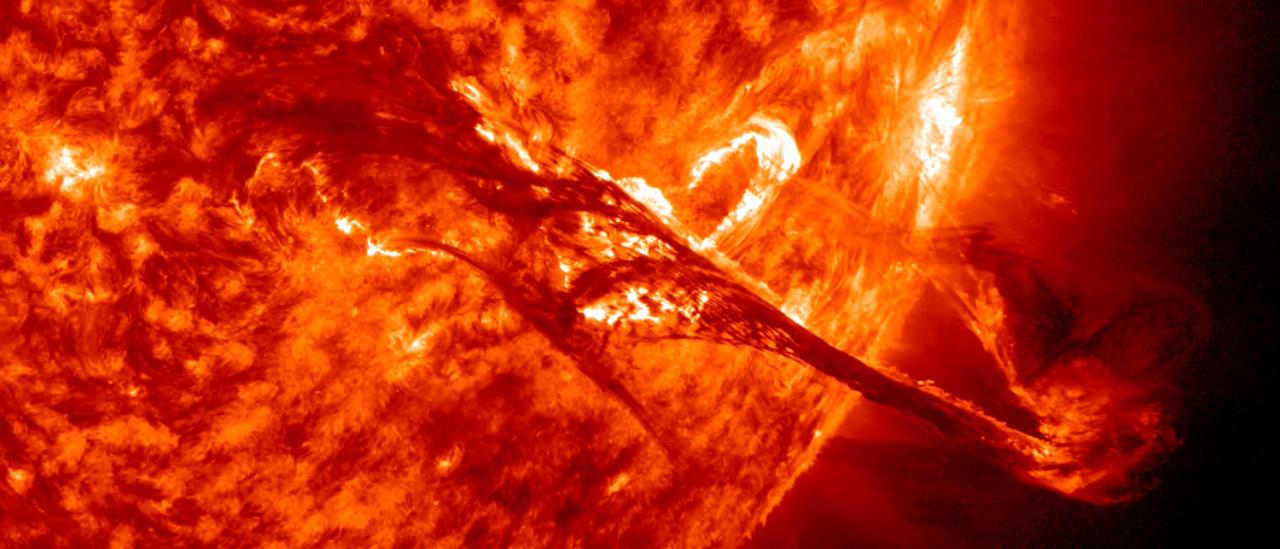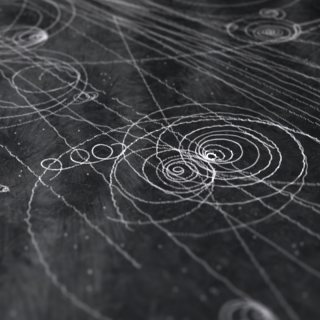Subvenciones relacionadas:
General
Los campos magnéticos son uno de los ingredientes fundamentales en la formación de estrellas y su evolución. En el nacimiento de una estrella, los campos magnéticos llegan a frenar su rotación durante el colapso de la nube molecular, y en el fin de la vida de una estrella, el magnetismo puede ser clave en la forma en la que se pierden las capas externas de forma dramática. En la vida adulta, el magnetismo da lugar a la actividad de las estrellas. Nuestro Sol tiene campos magnéticos que dan lugar a una actividad tan espectacular que es capaz de tener un impacto en la Tierra. Pero en otras estrellas, la actividad magnética es, en algunos casos, órdenes de magnitud más intensa que la solar, influenciando drásticamente el transporte de especies químicas y de momento angular, así como afectando posibles sistemas planetarios alrededor de éstas.
La finalidad de este Proyecto es estudiar diversas manifestaciones del campo magnético que se pueden observar en la atmosfera solar y en otras estrellas. Estas incluyen estructuras tan diversas como las manchas solares, los campos débiles presentes en el sol en calma o estructuras cromosféricas y coronales como los filamentos y las protuberancias. Así, se han ido abordando gradualmente los siguientes temas de investigación:
Magnetismo solar
- Estructura y evolución del campo magnético en manchas solares.
- Estructura y evolución del campo magnético en el Sol en calma.
- Estructura y evolución del campo magnético en la cromosfera y en estructuras cromosféricas (protuberancias, espículas,...)
- Estructura y evolución del campo magnético en bucles coronales.
- Estructura y evolución del campo magnético global del Sol. Estudios del ciclo de actividad magnética.
- Estudio empírico de la propagación de ondas magnetohidrodinámicas en el seno de estructuras magnéticas.
- Estudio empírico de mecanismos relacionados con el calentamiento de las capas externas del Sol.
- Estudio empírico de la influencia de la ionización parcial en la dinamica de la atmosfera solar.
- Implicación en el proyecto del Telescopio Solar Europeo.
Magnetismo estelar
- Desarrollo de métodos numéricos para el diagnóstico del campo magnético estelar, tanto en la superficie como en la cromosfera.
- Estudio del magnetismo en protuberancias estelares.
- Impacto del campo magnético en las últimas fases de la evolución estelar.
Miembros
Resultados
- Ondas espirales en manchas solares: Se han interpretado como ondas magnetoacústicas que se propagan desde el interior hasta capas atmosféricas siguiendo la dirección del campo magnético. Se ha caracterizado la topología del campo magnético de la mancha, descartando que la forma espiral sea consecuencia del retorcimiento de las líneas de campo (Felipe et al. 2019).
- Respuesta magnética a umbral flashes: Observaciones espectropolarimétricas simultáneas de las líneas cromosféricas He I 10830 y Ca II 8542 fueron usadas para estimar las fluctuaciones del campo magnético asociado a ondas de choque. Los choques provocan la expansión de las líneas de campo (Houston et al. 2018, incluye a A. Asensio Ramos).
Actividad científica
Publicaciones relacionadas
-
Numerical Simulations of Conversion to Alfvén Waves in Sunspots
We study the conversion of fast magnetoacoustic waves to Alfvén waves by means of 2.5D numerical simulations in a sunspot-like magnetic configuration. A fast, essentially acoustic, wave of a given frequency and wave number is generated below the surface and propagates upward through the Alfvén/acoustic equipartition layer where it splits into
Khomenko, E. et al.Fecha de publicación:
22012 -
High-resolution Observations of Siphon Flows in a Solar Magnetic Pore
We investigate signatures of siphon flows in a region around a solar magnetic pore, observed in the photosphere at μ = 0.6, during its decay phase. We analyze high-resolution Stokes spectra acquired by Hinode/Solar Optical Telescope along the Fe I pair at 630.2 nm. We determine the vector magnetic field and the line-of-sight velocity by an
Guglielmino, S. L. et al.Fecha de publicación:
122011 -
The Effects of Magnetic-field Geometry on Longitudinal Oscillations of Solar Prominences
We investigate the influence of the geometry of the solar filament magnetic structure on the large-amplitude longitudinal oscillations. A representative filament flux tube is modeled as composed of a cool thread centered in a dipped part with hot coronal regions on either side. We have found the normal modes of the system and establish that the
Luna, M. et al.Fecha de publicación:
92012 -
Rayleigh-Taylor Instability in Partially Ionized Compressible Plasmas
We study the modification of the classical criterion for the linear onset and growing rate of the Rayleigh-Taylor instability (RTI) in a partially ionized plasma in the two-fluid description. The plasma is composed of a neutral fluid and an electron-ion fluid, coupled by means of particle collisions. The governing linear equations and appropriate
Díaz, A. J. et al.Fecha de publicación:
72012 -
Kelvin-Helmholtz Instability in Partially Ionized Compressible Plasmas
The Kelvin-Helmholtz instability (KHI) has been observed in the solar atmosphere. Ion-neutral collisions may play a relevant role for the growth rate and evolution of the KHI in solar partially ionized plasmas such as in, e.g., solar prominences. Here, we investigate the linear phase of the KHI at an interface between two partially ionized
Soler, R. et al.Fecha de publicación:
42012 -
Ubiquitous quiet-Sun jets
Context. IMaX/Sunrise has recently reported the temporal evolution of highly dynamic and strongly Doppler shifted Stokes V signals in the quiet Sun. Aims: We attempt to identify the same quiet-Sun jets in the Hinode spectropolarimeter (SP) data set. Methods: We generate combinations of linear polarization magnetograms with blue- and redshifted far
Martínez-Pillet, V. et al.Fecha de publicación:
62011 -
The Wave-Front Correction System for the Sunrise Balloon-Borne Solar Observatory
This paper describes the wave-front correction system developed for the Sunrise balloon telescope, and it provides information about its in-flight performance. For the correction of low-order aberrations, a Correlating Wave-Front Sensor (CWS) was used. It consisted of a six-element Shack - Hartmann wave-front sensor (WFS), a fast tip-tilt mirror
Berkefeld, T. et al.Fecha de publicación:
12011 -
The Solar Orbiter Mission and its Polarimetric and Helioseismic Imager (SO/PHI)
We briefly outline the scientific and instrumental aspects of ESA's Solar Orbiter mission. Special emphasis is given to the Polarimetric and Helioseismic Imager, the instrument with the highest relevance for helioseismology applications, which will observe gas motions and the vector magnetic field in the photosphere at high spatial and temporal
Gandorfer, Achim et al.Fecha de publicación:
12011 -
SUNRISE Impressions from a successful science flight
SUNRISE is a balloon-borne telescope with an aperture of one meter. It is equipped with a filter imager for the UV wavelength range between 214 nm and 400 nm (SUFI), and with a spectro-polarimeter that measures the magnetic field of the photosphere using the Fe I line at 525.02 nm that has a Landé factor of 3. SUNRISE performed its first science
Schmidt, W. et al.Fecha de publicación:
62010 -
Spectropolarimetry of a Decaying Sunspot Penumbra
We report on high angular resolution, high-precision spectropolarimetric measurements of a decaying sunspot. The spot gradually lost its penumbra during the course of 3 days. In the late stages of evolution, where the only remnant of the spot is a naked umbra, we find small-scale inhomogeneities in the magnetic canopy surrounding it. The
Bellot Rubio, L. R. et al.Fecha de publicación:
32008 -
Spectropolarimetric multi line analysis of stellar magnetic fields
Aims: In this paper we study the feasibility of inferring the magnetic field from polarized multi line spectra using two methods: The pseudo line approach and The PCA-ZDI approach. Methods: We use multi line techniques, meaning that all the lines of a stellar spectrum contribute to obtain a polarization signature. The use of multiple lines
Ramírez Vélez, J. C. et al.Fecha de publicación:
32010 -
Solar Particle Acceleration Radiation and Kinetics (SPARK). A mission to understand the nature of particle acceleration
Energetic particles are critical components of plasma populations found throughout the universe. In many cases particles are accelerated to relativistic energies and represent a substantial fraction of the total energy of the system, thus requiring extremely efficient acceleration processes. The production of accelerated particles also appears
Matthews, Sarah A. et al.Fecha de publicación:
42012 -
POLAR investigation of the Sun—POLARIS
The POLAR Investigation of the Sun (POLARIS) mission uses a combination of a gravity assist and solar sail propulsion to place a spacecraft in a 0.48 AU circular orbit around the Sun with an inclination of 75° with respect to solar equator. This challenging orbit is made possible by the challenging development of solar sail propulsion. This first
Appourchaux, T. et al.Fecha de publicación:
32009 -
Non-detection of Magnetic Fields in the Central Stars of the Planetary Nebulae NGC 1360 and LSS 1362
The presence of magnetic fields is an attractive hypothesis for shaping planetary nebulae (PNe). We report on observations of the central star of the two PNe NGC 1360 and LSS 1326. We performed spectroscopy on circularly polarized light with the Focal Reducer and Low Dispersion Spectrograph at the Very Large Telescope of the European Southern
Leone, Francesco et al.Fecha de publicación:
42011 -
Emergence of Small-scale Magnetic Loops Through the Quiet Solar Atmosphere
We investigate the emergence of magnetic flux in the quiet Sun at very small spatial scales, focusing on the magnetic connection between the photosphere and chromosphere. The observational data consist of spectropolarimetric measurements and filtergrams taken with the Hinode satellite and the Dutch Open Telescope. We find that a significant
Martínez González, M. J. et al.Fecha de publicación:
82009 -
Detection of Vortex Tubes in Solar Granulation from Observations with SUNRISE
We have investigated a time series of continuum intensity maps and corresponding Dopplergrams of granulation in a very quiet solar region at the disk center, recorded with the Imaging Magnetograph eXperiment (IMaX) on board the balloon-borne solar observatory SUNRISE. We find that granules frequently show substructure in the form of lanes composed
Steiner, O. et al.Fecha de publicación:
112010 -
Assessing the Behavior of Modern Solar Magnetographs and Spectropolarimeters
The design and later use of modern spectropolarimeters and magnetographs require a number of tolerance specifications that allow the developers to build the instrument and then the scientists to interpret the data accuracy. Such specifications depend both on device-specific features and on the physical assumptions underlying the particular
Del Toro Iniesta, J. C. et al.Fecha de publicación:
82012 -
The Three-dimensional Structure of an Active Region Filament as Extrapolated from Photospheric and Chromospheric Observations
The three-dimensional structure of an active region filament is studied using nonlinear force-free field extrapolations based on simultaneous observations at a photospheric and a chromospheric height. To that end, we used the Si I 10827 Å line and the He I 10830 Å triplet obtained with the Tenerife Infrared Polarimeter at the Vacuum Tower Telescope
Yelles-Chaouche, L. et al.Fecha de publicación:
32012 -
Magnetic field strength of active region filaments
Aims: We study the vector magnetic field of a filament observed over a compact active region neutral line. Methods: Spectropolarimetric data acquired with TIP-II (VTT, Tenerife, Spain) of the 10 830 Å spectral region provide full Stokes vectors that were analyzed using three different methods: magnetograph analysis, Milne-Eddington inversions, and
Kuckein, C. et al.Fecha de publicación:
72009 -
An active region filament studied simultaneously in the chromosphere and photosphere. II. Doppler velocities<xref ref-type="fn" rid="FN1">
Context. Paper I presents the magnetic structure, inferred for the photosphere and the chromosphere, of a filament that developed in active region (AR) NOAA 10781, observed on 2005 July 3 and July 5. Aims: In this paper we complement those results with the velocities retrieved from Doppler shifts measured at the chromosphere and the photosphere in
Kuckein, C. et al.Fecha de publicación:
62012



